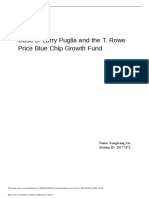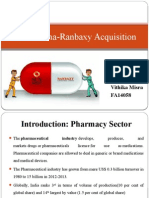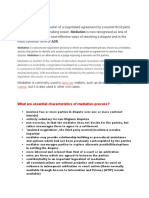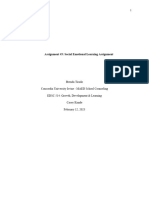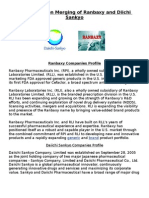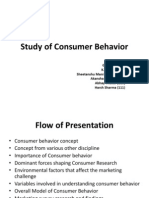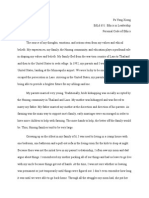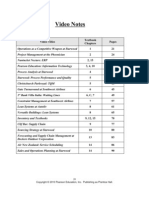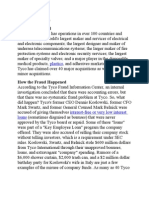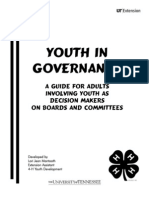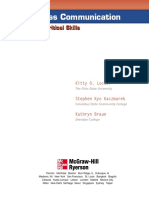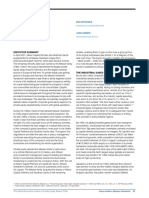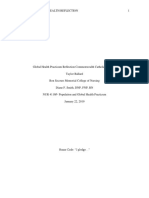Introduction To Social Awareness
Introduction To Social Awareness
Uploaded by
piyushCopyright:
Available Formats
Introduction To Social Awareness
Introduction To Social Awareness
Uploaded by
piyushOriginal Title
Copyright
Available Formats
Share this document
Did you find this document useful?
Is this content inappropriate?
Copyright:
Available Formats
Introduction To Social Awareness
Introduction To Social Awareness
Uploaded by
piyushCopyright:
Available Formats
Introduction to Social Awareness
Social Awareness is the ability to take the perspective of and empathize with others from diverse
backgrounds and cultures; to understand social and ethical norms for behavior; and to recognize family,
school, and community resources and supports. 1 Social awareness is a crucial component of appropriate
Overview
classroom behavior, which contributes to an environment conducive to learning. Social awareness is also
widely established as an important factor in workforce success. One recent employer survey conducted by
the Partnership for 21st Century Skills demonstrates that four of the five most important skills for high
school graduates entering the work force are linked to social awareness: professionalism, collaboration,
communication, and social responsibility. 2
Why This Matters: Social awareness may contribute to better behavior and achievement in
school and increased engagement with community and school resources:
Positive Classroom Climate: Students with strong social awareness can more easily adapt to
their environment, empathize with the perspectives of others, and engage in fewer disruptive
classroom behaviors. This,
in turn, creates an
environment where
students can focus on
learning.3
Better Relationships:
Students who demonstrate
strong social awareness are
able to engage in
constructive communication
with their peers and resolve
conflicts when they arise. These students benefit from peer learning and know how to take
advantage of social supports.4
Fewer Risky Behaviors: Students who are able to adapt to new environments, understand the
needs and perspectives of others, and know where to get support when they need it are less
prone to emotional distress and less likely to engage in risk behaviors, such as drug use and
aggression, that interfere with school success.5
1 CASEL.org (http://www.casel.org/social-and-emotional-learning/core-competencies/)
2 Casner-Lotto, J., & Barrington, L. (2006). Are They Really Ready to Work? Employers' Perspectives on the Basic
Knowledge and Applied Skills of New Entrants to the 21st Century US Workforce. Partnership for 21st Century Skills.
1 Massachusetts Avenue NW Suite 700, Washington, DC 20001.
3 Greenberg, M. T., Weissberg, R. P., O'Brien, M. U., Zins, J. E., Fredericks, L., Resnik, H., & Elias, M. J. (2003).
Enhancing school-based prevention and youth development through coordinated social, emotional, and academic
learning. American psychologist, 58(6-7), 466.
4 Gehlbach, H., Young, L. V., & Roan, L. K. (2012). Teaching social perspective taking: how educators might learn
from the Army. Educational Psychology, 32(3), 295-309.
5 Greenberg, et al. (2003).
© 2014 Transforming Education. This work is licensed under the Creative Commons Attribution-NonCommercial-ShareAlike 4.0 International License. To view a copy
of this license, visit http://creativecommons.org/licenses/by-nc-sa/4.0/.
You might also like
- Aep PermitDocument2 pagesAep Permitftb1No ratings yet
- The Implementation and Measurement of Outcomes With BeefsteakDocument11 pagesThe Implementation and Measurement of Outcomes With BeefsteakRed Door BoutiqueNo ratings yet
- Pricing PDFDocument113 pagesPricing PDFmmanoNo ratings yet
- 64 Research ProposalDocument3 pages64 Research ProposalVishwa NidhiNo ratings yet
- Larry Puglia Case - 3Document6 pagesLarry Puglia Case - 3Albert ShihNo ratings yet
- SB4001 Part 2 Assessment TemplateDocument11 pagesSB4001 Part 2 Assessment TemplatePaul MumoNo ratings yet
- When It Is Legal To Lie in NegotiationsDocument9 pagesWhen It Is Legal To Lie in NegotiationsLaura Yanina Ortiz VázquezNo ratings yet
- MGW1010 AssignmentDocument4 pagesMGW1010 AssignmentVenessa YongNo ratings yet
- Outline June 25Document53 pagesOutline June 25Kiko Omar White100% (1)
- Research PaperDocument13 pagesResearch PaperCh RafayNo ratings yet
- Leading & Influencing Motivating & Communicating ControllingDocument22 pagesLeading & Influencing Motivating & Communicating ControllingChristian Jim PollerosNo ratings yet
- CISA Exam Prep Domain 3-2019Document129 pagesCISA Exam Prep Domain 3-2019poornima24100% (1)
- Preventive DetentionDocument42 pagesPreventive DetentionSamar MavinkurveNo ratings yet
- Octapace Case1Document14 pagesOctapace Case1Ravindra DeyNo ratings yet
- BECG Group No.7 - INFOSYSDocument2 pagesBECG Group No.7 - INFOSYSAmit BhalaniNo ratings yet
- Case SummaryDocument12 pagesCase Summarykhazima UmairNo ratings yet
- Merger and AcquisitionDocument26 pagesMerger and AcquisitionAre HidayuNo ratings yet
- Monitor Company Case AnalysisDocument6 pagesMonitor Company Case AnalysisNeel JadhavNo ratings yet
- Assignment On OBDocument24 pagesAssignment On OBHarshit MarooNo ratings yet
- Sun's Acquisition of Ranbaxy PharmaDocument15 pagesSun's Acquisition of Ranbaxy PharmaPrateek LoganiNo ratings yet
- SME Analysis - Halo EffectDocument6 pagesSME Analysis - Halo EffectFabiola AmedoNo ratings yet
- Ethical DilemmaDocument5 pagesEthical Dilemmaumesh pradhanNo ratings yet
- Introduction To Affinity Diagrams and Pareto ChartsDocument20 pagesIntroduction To Affinity Diagrams and Pareto ChartsAmit SenNo ratings yet
- DocumentDocument18 pagesDocumentSajid KhanNo ratings yet
- Grameen BankDocument5 pagesGrameen BankNitin ChidrawarNo ratings yet
- CaseDocument23 pagesCaseNguyễnVũHoàngTấnNo ratings yet
- Assignment 3 Social Emotional LearningDocument6 pagesAssignment 3 Social Emotional Learningapi-745007760No ratings yet
- Agency ProblemDocument6 pagesAgency ProblemZarkaif KhanNo ratings yet
- Emotional IntelligenceDocument26 pagesEmotional IntelligenceNisha MalhotraNo ratings yet
- What More Evidence Do You Need?: HBR Case Study by Anthony R. KovnerDocument5 pagesWhat More Evidence Do You Need?: HBR Case Study by Anthony R. KovnerTemporary MailNo ratings yet
- The London Whale/ VoldemortDocument9 pagesThe London Whale/ VoldemortMirza Saaib BégNo ratings yet
- Analysis On Combating Hostile TakeoversDocument14 pagesAnalysis On Combating Hostile TakeoversLAW MANTRANo ratings yet
- (Self-) Assessment of Intercultural Communication CompetenceDocument15 pages(Self-) Assessment of Intercultural Communication CompetenceAna SanduNo ratings yet
- 09 Chapter1 PDFDocument20 pages09 Chapter1 PDFRobert CostalesNo ratings yet
- Assignment 2 - Summary of Global Virtual TeamsDocument4 pagesAssignment 2 - Summary of Global Virtual Teamssamisay2000No ratings yet
- ConsumerDocument6 pagesConsumerRAoNo ratings yet
- Ogl 300 Final PaperDocument8 pagesOgl 300 Final Paperapi-554893928No ratings yet
- Hofstede OutputDocument7 pagesHofstede OutputPavan Reddy MareddyNo ratings yet
- Case Study On Merging of Ranbaxy and Diichi SankyoDocument13 pagesCase Study On Merging of Ranbaxy and Diichi SankyoLavanya PrabhakaranNo ratings yet
- Fixed Income Markets - Term-V - Prof. Vivek RajvanshiDocument5 pagesFixed Income Markets - Term-V - Prof. Vivek RajvanshiAcademic Management SystemNo ratings yet
- Consumer Behavior FinalDocument23 pagesConsumer Behavior FinalHarsh Sharma100% (1)
- Personal Code of EthicsDocument6 pagesPersonal Code of Ethicsapi-283612345No ratings yet
- Parable of Sadhu - ExtractDocument3 pagesParable of Sadhu - ExtractTavleen KaurNo ratings yet
- ... Rm9 Irm Ch00-VideoDocument75 pages... Rm9 Irm Ch00-VideoRenae AjayiNo ratings yet
- Course Outline 2017Document5 pagesCourse Outline 2017agrawalrishiNo ratings yet
- Tyco Fraud CaseDocument7 pagesTyco Fraud CaseAlisha Ashish88% (8)
- What Is The BCG GrowthDocument14 pagesWhat Is The BCG GrowthAngna DewanNo ratings yet
- Youth in GovernanceDocument8 pagesYouth in Governanceapi-26649203No ratings yet
- Behavioral Finance: Jay R. RitterDocument9 pagesBehavioral Finance: Jay R. RitterTehreema KazmiNo ratings yet
- Friedman Doctrine NotesDocument3 pagesFriedman Doctrine NotesHimanshu MehraNo ratings yet
- Power That Builds Others and Power That Breaks Effects of Power and Humility On Altruism and Incivility in Female EmployeesDocument25 pagesPower That Builds Others and Power That Breaks Effects of Power and Humility On Altruism and Incivility in Female EmployeesTaimur KhattakNo ratings yet
- Microfinance: An Emerging Asset Class?Document16 pagesMicrofinance: An Emerging Asset Class?AhmedShujaNo ratings yet
- Prelims PDFDocument19 pagesPrelims PDFbintar_2150% (2)
- A Day in The Life of Alex Sander Group 5Document12 pagesA Day in The Life of Alex Sander Group 5Hitesh Diyora100% (1)
- Ziqitza Healthcare Limited Challenge of Scaling Up Emergency MedicalDocument18 pagesZiqitza Healthcare Limited Challenge of Scaling Up Emergency MedicalYadav KrishnaNo ratings yet
- Running Head: Huge and Digital Strategy 1Document8 pagesRunning Head: Huge and Digital Strategy 1Amir GhasdiNo ratings yet
- WEF2008 MesserDocument12 pagesWEF2008 MesserArunabha AichNo ratings yet
- The 4 Types of Organizational Politics: Michael Jarrett Save Share Print Buy CopiesDocument8 pagesThe 4 Types of Organizational Politics: Michael Jarrett Save Share Print Buy CopiesDarry BlanciaNo ratings yet
- Ethics, CSR & Corporate BehaviorDocument50 pagesEthics, CSR & Corporate BehaviorSakshi Khurana100% (2)
- American Airlines ReportDocument13 pagesAmerican Airlines ReportAlisa BisopNo ratings yet
- Malden MillsDocument3 pagesMalden MillsBrian Watts100% (1)
- TERM PAPER GlaxoSmithKline Bangladesh LimitedDocument36 pagesTERM PAPER GlaxoSmithKline Bangladesh LimitedTanvirNo ratings yet
- 5-Social Skills Among Children at Elementary LevelDocument10 pages5-Social Skills Among Children at Elementary LevelBungsuNo ratings yet
- Teaching Methods in Nursing EducationDocument29 pagesTeaching Methods in Nursing EducationAlyssa Santos JavierNo ratings yet
- Lesson 5: Selected Indigenous Science and Technology in The PhilippinesDocument12 pagesLesson 5: Selected Indigenous Science and Technology in The PhilippinesRINOA KEISHA CORTEZNo ratings yet
- Malayang Samahan NG Mga Manggagawa Vs Ramos 326 SCRA 428 (2000)Document12 pagesMalayang Samahan NG Mga Manggagawa Vs Ramos 326 SCRA 428 (2000)sakuraNo ratings yet
- Molina GuidelinesDocument2 pagesMolina GuidelinesPaul Jordan BerguiaNo ratings yet
- Recreation: Other Values That You Can Derive From Engaging in Worthwhile Recreational ActivitiesDocument1 pageRecreation: Other Values That You Can Derive From Engaging in Worthwhile Recreational ActivitiesUnibelle Joy LachicaNo ratings yet
- Lesson 2 Suheil PDFDocument14 pagesLesson 2 Suheil PDFrusilawati salleh100% (1)
- The World's Cleverest Dog: Alex The African Grey Parrot: A Genius?Document1 pageThe World's Cleverest Dog: Alex The African Grey Parrot: A Genius?Alexandra VilaplanaNo ratings yet
- The IllestDocument6 pagesThe IllestYasmine CherNo ratings yet
- WEEK 13-14 Late Childhood: It Coincides With The Child's Elementary School YearsDocument5 pagesWEEK 13-14 Late Childhood: It Coincides With The Child's Elementary School YearsSienna LeeNo ratings yet
- Time Headway Distribution of Vehicles: A Project Report OnDocument23 pagesTime Headway Distribution of Vehicles: A Project Report OnHimanshu ChaudharyNo ratings yet
- Business Research: Mr. Crisologo A. Damayo, CPA, EMBADocument14 pagesBusiness Research: Mr. Crisologo A. Damayo, CPA, EMBAEdmark PedranoNo ratings yet
- Module 3: Identify Opportunities: What Do I Need To Do?Document3 pagesModule 3: Identify Opportunities: What Do I Need To Do?Eda Angela Oab100% (2)
- Drug Related Cases 1Document10 pagesDrug Related Cases 1janzNo ratings yet
- Actividad Fundamental 5 Cultura InglesaDocument2 pagesActividad Fundamental 5 Cultura InglesaFrancisco AnzuresNo ratings yet
- Advanced Test 1 Keynote: ReadingDocument5 pagesAdvanced Test 1 Keynote: ReadingMiriam González LavinNo ratings yet
- Yebes IdpDocument1 pageYebes IdpJeffriel Monares LingolingoNo ratings yet
- June 2014 Mark Scheme 31Document9 pagesJune 2014 Mark Scheme 31rajeshbarasaraNo ratings yet
- Practicum Reflection Global HealthDocument4 pagesPracticum Reflection Global Healthapi-485309966No ratings yet
- How To Sell A ProductDocument4 pagesHow To Sell A ProductPoorna ChandraNo ratings yet
- Maternity Benefit in BangladeshDocument17 pagesMaternity Benefit in BangladeshK_Hasan88% (17)
- Cohabitation Before Marriage As A Risk For DivorceDocument4 pagesCohabitation Before Marriage As A Risk For Divorce17 ENo ratings yet
- Illegal Access: Types of CybercrimeDocument4 pagesIllegal Access: Types of CybercrimeJessica Labis-TibayanNo ratings yet
- Destination Image (Tourism) - Texto Complementar IDocument23 pagesDestination Image (Tourism) - Texto Complementar IThamirys David100% (1)
- Theories of European IntegrationDocument12 pagesTheories of European IntegrationEthy RealNo ratings yet
- The Influence of Authentic Leadership On Creativity and InnovativenessDocument9 pagesThe Influence of Authentic Leadership On Creativity and InnovativenessGunalatcumy KarunanitheNo ratings yet
- S03a CompAdv PDFDocument7 pagesS03a CompAdv PDFJhai LaitaNo ratings yet




